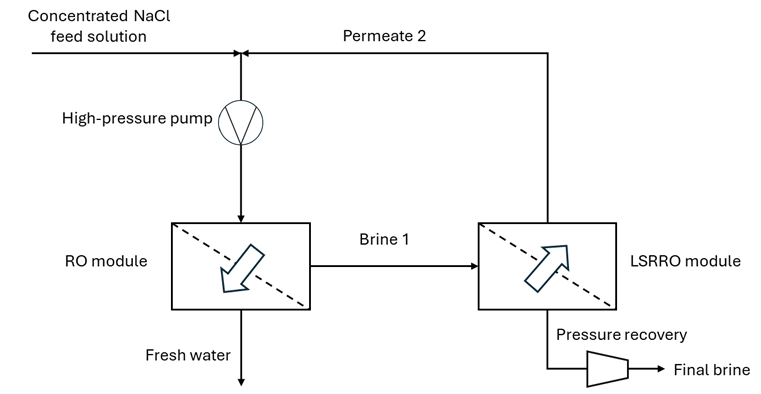Low-Salt-Rejection Reverse Osmosis (LSRRO) membrane solutions and technologies for the concentration of highly saline streams
- Persons involved: Lena Riechers (PhD), Gerrald Bargeman (promotor), Sander Haase (co-promotor)
- Duration: 2024-2028
- Funding: TKI Energie & Industrie, via project Odysseus formed by the consortium UTwente, Nobian, Shell, Lenntech, Colubris and ISPT
Introduction /motivation
The discharge of concentrated salt water in seas and rivers often disturbs the aquatic ecosystems. To minimize environmental risk and maximize the availability of clean water, the minimum or zero liquid discharge concept became an important goal for many companies that produce salty wastewater streams [1,2]. Currently, zero liquid discharge is typically achieved by using thermally-driven phase transition-based processes. However, those processes have very high energy consumptions and high capital costs. For minimum liquid discharge filtration-based processes, usually reverse osmosis (RO) membranes are used as a first concentration step. This reduces the energy consumption dramatically [3]. Nevertheless, RO cannot completely replace the thermal brine concentrator due to limitations on the operating pressure. Low-Salt-Rejection RO (LSRRO) is a technology that can overcome this pressure limitation by using so-called ‘loose RO’ or LSRRO membranes. LSRRO membranes have a salt retention between that of RO and nanofiltration (NF) membranes, leading to reduced osmotic pressure difference between concentrate and permeate. As a result, the required transmembrane pressure is lower than that for RO membranes for a given concentration factor [1,3]. Hence, LSRRO technology allows the production of concentrates with higher salt concentrations than achievable with conventional RO, which is why this technology is very promising.

Figure 1: LSRRO process with RO module in first stage and LSRRO module in second stage.
Key words
Low-Salt-Rejection reverse osmosis, membrane, desalination, brine
Technological/Scientific challenges
One challenge is to find suitable membranes, which can handle high pressures, but also have a high flux, and a salt retention between that of RO and NF membranes. Furthermore, due to the high salinities and the presence of impurities such as divalent salts and organics, minimization of concentration polarization and fouling for LSRRO membranes will be challenging.
Research goals/research questions
Optimizing the LSRRO process by evaluating and modifying membranes, and determining the performance on lab- as well as module-scale.
References
- G. Bargeman, “Maximum allowable retention for low-salt-rejection reverse osmosis membranes and its effect on concentrating undersaturated NaCl solutions to saturation,” Sep Purif Technol, vol. 317, 2023, doi: 10.1016/j.seppur.2023.123854.
- Y. Du, Z. Wang, N. J. Cooper, J. Gilron, and M. Elimelech, “Module-scale analysis of low-salt-rejection reverse osmosis: Design guidelines and system performance,” Water Res, vol. 209, 2022, doi: 10.1016/j.watres.2021.117936.
- Z. Wang, A. Deshmukh, Y. Du, and M. Elimelech, “Minimal and zero liquid discharge with reverse osmosis using low-salt-rejection membranes,” Water Res, vol. 170, 2020, doi: 10.1016/j.watres.2019.115317.

